Here are some examples of research projects conducted by undergraduate students. Undergraduate students at OSU interested in helping with existing research projects or conducting their own independent research should email me or come by my office hours.
An ethnographic Study of Defensive Strategies in Basketball
Michael Doulas (2022-2023)
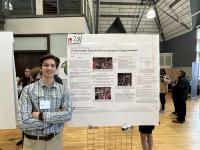
Michael examined whether and how the quantification of steal and block statistics affect player defensive decision-making and how teams play defense? Blocks and steals are the only defensive statistics in box scores, but they are not reflective of the range of defensive strategies. Michael used an ethnographic approach to study defensive play of the Ohio State men’s basketball team. He observed practices and games and interviewed players and coaches. He found that block and steal statistics seem to have little effect on team defensive strategies, but they do reflect successful defense. Additionally, he learned about many other unquantified defensive practices that also contribute to successful defense. Given the importance of both measured and unmeasured practices, Michael recommends that future research should focus on creating modes of analysis that integrate both quantitative and qualitative measurements of defense.
Tracking Ideal Free Distribution in "real time"
Joshua Tovuor (2015-2017)

Joshua Tovuor majored in Geographic Information Science with a minor in Engineering Science. His interests are: mapping, spatial analysis, modeling, and simulations. Joshua managed the transhumance data and campsite location data that we collected in Cameroon from 2008 to 2016. In addition, Joshua used the transhumance data to examine whether pastoralists distribute themselves in an ideal free distribution in the Logone Floodplain from November to May for five years (2007-2012).
Demography of Mobile Pastoralists in Cameroon
Sophia Kiselova-Sammons (2015-2017)

Sophia majored in Anthropology, Russian, and French. She organized and analyzed data from a demographic survey of mobile pastoralists that we conducted in 2008. Sophia used statistical analyses to describe and analyze the demographic patterns and compare them with other studies of pastoral demography. The data will be used to validate an agent-based model of pastoral households and herds.
Tracking grazing pressure in the Logone Floodplain, 1994-2014
John Baltes (2016-2017)

John Baltes studied Climatology and Biology. John used data from our annual transhumance surveys to examine how grazing pressure has changed in the last two decades in the Logone Floodplain. He updated an earlier study of grazing pressure (1994-1999) that was published in the journal Human Ecology and used the same method to analyze new data (2007-2014). As a climatologist in training, John is interested in examining how climate change is affecting pastoralists in the Far North Region of Cameroon.
Impact of Pastoralist Refugees on the Ideal Free Distribution
Tori Garcia (2016-2017)

Tori Garcia graduated with a degree in Geographic Information Science. She worked on the RAPID project where she used spatial analysis to determine if pastoralists distribute themselves in an Ideal Free Distribution. In an earlier project we found that pastoralists in the Logone Floodplain distribute themselves in an ideal free distribution in the dry season. However, in the last couple of years, hundreds of pastoralists have fled the terror of Boko Haram in Northeast Nigeria and moved to the Far North Region of Cameroon where they spend the dry season in the Logone Floodplain. Tori worked with remotely sensed data of vegetation quality and quantity and GPS data of pastoralists' campsites to examine the impact of the influx of pastoralist' refugees from Nigeria on the Ideal Free Distribution.
Hunters and Wildlife Diseases: Risk Perceptions and Practices
Pallavi Oruganti (2013-2015)
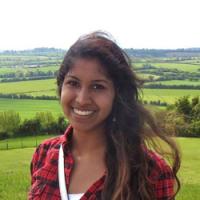
Pallavi’s research project examined hunters’ knowledge, attitudes and practices related to infectious wildlife disease in Southeast Ohio. There are a number of infectious diseases that pose risks for humans and/or livestock, including neosporosis, Brucellosis and bovine tuberculosis. Hunters potentially represent a critical link in the transmission of infectious diseases from wildlife to livestock because many hunters are also farmers. However, it is unclear how much hunters know about the potential risks of these infectious diseases and whether and how that knowledge informs hunting practices. Pallavi’s research documented hunters’ knowledge, attitudes, and practices of these infectious diseases as well as examine the connections between these three. For example, is there a correlation between knowledge and practice when it comes to minimizing the risk of exposure to infectious diseases when field dressing deer. In addition, Pallavi examined how and from whom hunters learn about the risks of infectious diseases and how this affects their hunting practices. Her findings may contribute to more effective interventions that improve the health and well being of humans and animals in the region.
Mobility of Herds Under Contract
Sara Handa (2012-2013)

Sara used our data set on pastoral mobility to examine whether herds under contract, i.e., herds owned by absentee owners, have different mobility patterns than those of herds owned by independent herders. Using a combination of spatial and statistical analysis, Sara examined whether the percentage of herds under contract in a camp is correlated with their distribution within the dry and rainy season grazing areas and whether there were any differences in mobility patterns between camps with more or less herds under contract. The results of the study show that there no major differences between herds under contract and those that are independently owned, which is contrary to what has been argued in the literature on absentee owners.The results were published in Human Ecology (2015).
Infectious Diseases and Pastoralists’ Decision-Making
Jessica Healy (2011-2012)
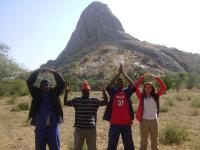
This project’s goal was to better understand the ways in which pastoralists’ decision-making concerning infectious diseases shape the transmission of infectious disease among humans and animals. Jessica’s research project examined the connection between pastoralists’ decisions on the disease management of their cattle and the overall fertility of the herd. Over the past fifty years, various studies have found that pastoralists’ breeding strategies are focused on the long-term longevity of the herd. Researchers from the Disease Ecology and Computer Modeling Laboratory (DECML) have noted that despite the long-term goal of herd longevity, herders do not always remove chronically ill cattle from their herds-putting healthy cattle (and humans) at risk. Several diseases endemic in the area (e.g., Brucellosis) are highly contagious and negatively affect the reproductive fertility of the herd. Thus it would seem to an outsider that keeping a sick cow within the herd would not only risk the fertility of the sick animal, but also the fertility of the whole herd. Despite the risk, keeping sick animals in the herd appears to be common. Jessica examined why pastoralists keep chronically sick animals in their herd. Jessica presented preliminary results at the Denman Undergraduate Research Forum and won second place in the Social and Behavioral Sciences category. We published the findings of Jessica's research in the journal Pastoralism (2013).
Can One Animal Represent an Entire Herd?
Zachary Galehouse (2011)
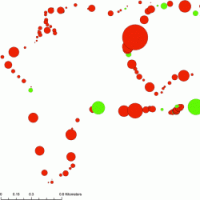
Researchers have been using GPS/GIS technology to study spatiotemporal patterns in pastoral mobility under the assumption that the behavior of one animal is representative of the entire herd. The question is whether that is indeed the case since cattle herds may consist of animals of different sex, age, breed, and reproductive status. Moreover, the social hierarchy and spatial position of animals within the herd may result in variation in grazing patterns. To examine whether one animal can represent the grazing and mobility patterns of the whole herd, we put multiple GPS tracking devices on different animals in two separate herds. Zachary analyzed the spatial data we collected. The results indicate that one animal is indeed representative of an entire cattle herd in mobile pastoral systems. The results are published in Human Ecology (2012).
Modeling Movements of Pastoralists in the Logone Floodplain
Jeff Cronley, Hongyang Pi, and Paul Maddock (2010-2011)
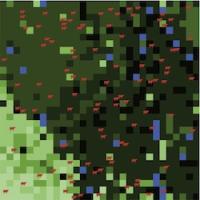
This project examined how mobile pastoralists in the Logone Floodplain in the Far North Region of Cameroon coordinate their movements to avoid conflict and overgrazing in a land tenure system that is commonly described as open access, a situation generally regarded as leading to a tragedy of the commons (Hardin 1968). The hypothesis is that this management system is best understood as a case of emerging complexity, in which individual decision-making, coordination of movements among pastoralists, and participation in an information sharing network result in the emergence of a complex adaptive system in which access to and use of grazing resources is managed. The hypothesis is examined using agent-based modeling (ABM). Jeff, Hongyang, and Paul used spatial, ecological and ethnographic data to build a model using NetLogo. The model will allow us to examine under what conditions and/or following what rules pastoralists are able to achieve an Ideal Free Distribution (IFD). This study was part of the Research for Undergraduates: adventures in Mathematical Biology and its Applications (RUMBA) program at OSU. The project resulted in an article that was published in Ecological Modeling (2015).
A Study of Pastoralists’ Ethnoveterinary Knowledge
Daniel Ewing (2010)
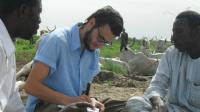
This study of ethnomedical systems of mobile pastoralists in the Far North Region of Cameroon examined the claim that pastoralists in the Chad Basin do recognize the concept of zoonotic diseases, but instead belief that there are human and animal diseases. Because pastoralists live in such close proximity to their livestock the risk of infection from zoonotic diseases like tuberculosis and brucellosis is very high. Daniel used a combination of freelists and semi-structured interviews to study pastoralists’ knowledge. The results suggest that pastoralists do not have a concept for zoonotic diseases. Moreover, Daniel also found considerable variation in pastoralists' ethnoveterinary knowledge and examples of not knowing, which contrasts with previous studies that do not describe much variation in ethnoveterinary knowledge. We published the results from Daniel's study in Human Organization (2013).
Livelihoods of Hired Herders in the Far North of Cameroon
Kristen Ritchey (2008-2009)
In the last four decades there has been a shift in livestock ownership in African pastoral systems from subsistence herders to absentee owners who use salaried herders to manage their livestock. Previous studies suggest that these labor relations are exploitative and therefore have a negative effect on herd and land management. However, there have been few studies that systematically examine these labor relations and their effect on herd and land management. Kristen's research investigated whether these labor relations are exploitative by examining if contracts provide sustainable livelihoods and allow for socio-economic mobility of hired herders. She also examined if herders engage in these contracts because they prefer a herding life and/or see no other livelihood options. Kristen conducted an ethnographic study from January to March 2009 in the Far North Region of Cameroon where she interviewed hired herders, herd owners, and independent herders. The analysis shows that there is great variation in herding contracts, livelihoods, and socio-economic mobility. Most hired herders are barely making a living but continue to engage in herding contracts because they prefer the herding life to other livelihoods. A few hired herders are able to become independent but only if they own animals and are responsible financially. The study shows that most hired herders will not achieve economic independence, but also that this does not necessarily lead to poor herd management as previous studies suggest. The results were published in the Journal of Modern African Studies (2011) (PDF).
Modeling Grazing Pressure in the Logone Floodplain
Eric Soma, Leah Taylor, and Todd Juran (2009)
The discussion about the impact of pastoral systems on ecosystems has been profoundly shaped by Hardin’s tragedy of the commons argument that held pastoralists responsible for overgrazing the range. Recent studies have shown that grazing ecosystems are much more complex and dynamic than was previously assumed and that pastoralists adaptively manage these systems. However, we still have little understanding how everyday herding affects ecosystems at the landscape level. We conducted a study of daily herd movements and grazing strategies in a mobile pastoral system in the Logone floodplain, Cameroon. We integrated GPS/GIS technology, video recordings of animal behavior, and ethnographic methods to develop a more accurate measurement of grazing pressure that takes into account both livestock densities and grazing behavior. Eric, Leah, and Todd used ArcGIS to analyze the spatial data we collected of daily herd movements and used it to model grazing pressure in the Logone Floodplain. The results were published in Human Ecology (2010) (PDF).
Mapping Mobile Pastoralists in the Logone Floodplain
Katelyn Victor and Luciano Landaburu (2008)

Katelyn and Luciano created several maps for a poster that we presented at the annual meetings of the American Anthropological Association in San Francisco, November 2008. In this poster we presented preliminary results from the longitudinal, multidisciplinary study that examines how mobile pastoralists in the Logone floodplain coordinate their movements to avoid conflict and overgrazing in a land tenure system that is commonly described as open access. The preliminary maps show that the floodplain, which we initially conceived as one contiguous camp zone, is subdivided in multiple, distinct “patches” or camping zones.
